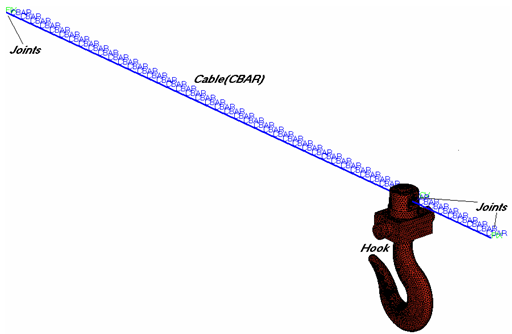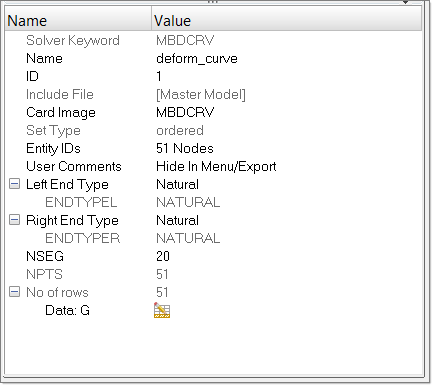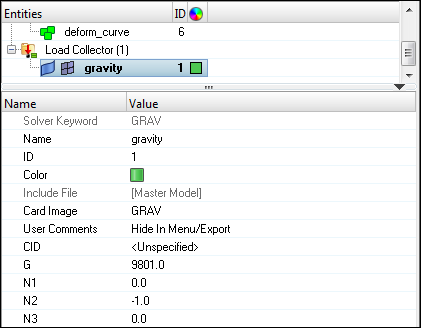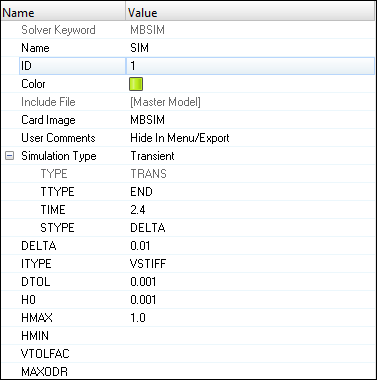In this tutorial, a multi-body dynamics analysis (simulation type: Transient Analysis) of a hook on a flexible cable are performed using OptiStruct. An existing finite element model is imported into HyperMesh. The rest of the setup (creation of joint, loading, etc.) is done in HyperMesh. HyperView is used to post-process the large deformations of the flexible cable model.

Hook rolling on a cable
In this tutorial, you learn how to create JOINTS (Fixed, PTDCV), a PFBODY, a PRBODY, an MBDCRV, and a multi-body dynamics subcase.

Model in HyperMesh
The flexible cable consists of 50 different CBAR elements (PFBODY) and the end of this flexible body is connected to ground (GROUND) using fixed joints.
The Hook (PRBODY) is an external graphic and is connected to the flexible cable by the PTDCV joint.
This exercise will show how to:
| • | Load a model into HyperMesh |
| • | Create a component for JOINT |
| • | Adding a displacement motion to the model |
| • | Create load collectors for GRAV and MBSIM |
| • | Create a multi-body dynamics subcase |
| • | Post-process the results in HyperView |
Exercise
Step 1: Define the OptiStruct User Profile and retrieve the finite element model
| 1. | Launch HyperMesh Desktop and select OptiStruct in the User Profiles dialog. |
| 2. | Click File > Open > Model. An Open Model browser window opens. |
| 3. | Select the flex_cable.hm file you saved to your working directory from the optistruct.zip file. Refer to Accessing the Model Files. |
| 4. | Click Open. The flex_cable.hm database is loaded into the current HyperMesh session, replacing any existing data. |
Create a PRBODY/GROUND and PFBODY (Steps 2 - 5)
Step 2: Create the rigid body (PRBODY)
| 1. | From the Analysis page, click bodies. |
| 2. | Select the create subpanel. |
| 3. | Click body= and enter Hook. |
| 4. | Click type= and select PRBODY. |
| 5. | Click props under properties: and check the box for Hook. |
| 7. | Under free nodes:, click nodes and select the option by id and enter node ID 14399. |
Step 3: Create flex body (PFBODY)
| 1. | Click body= and enter Cable. |
| 2. | Click type= and select PFBODY. |
| 3. | Click props under properties: and check the box for Cable. |
| 5. | Under free nodes:, click nodes and select the option by id and enter node IDs 1, 2. |
| 6. | For CMS Method:, verify that Craig-Bampton (CB) is selected. |
| 7. | For frequency upper bound: verify that upper bound default is selected. |
| 8. | For number of modes:, select nmodes= and enter the value 15. |

Step 4: Create ground body (GROUND)
| 1. | Click body= and enter Ground. |
| 2. | Click type= and select GROUND. |
| 3. | Under free nodes:, click nodes and select the option by id and enter node IDs 14397, 14398. |
| Note: | To define the ground body, the selection of props is not required. |
|
Step 5: Define the deformable curve
| 1. | In the Model browser, right-click and select Create > Set. |
| 2. | For Name, enter deform_curve. |
| 3. | Click Card Image and select MBDCRV from the drop-down menu and click Yes to confirm. |
| 4. | Confirm Set Type is set to ordered. |
| 5. | For Entity IDs, click Nodes and click on node list selector in the panel under the graphics area. |
| 6. | Click by path from the extended selection menu. |
| 7. | Select the nodes at two ends of the flexible cable made up by CBAR elements. See that all the nodes are automatically selected on the cable. |

Step 6: Create the component for the joints
Here, you will define all the necessary joints including the PTDCV joint. Three joints for the model are needed. Two fixed joints between the Cable ends to the Ground and one PTDCRV between the Hook and the Cable.
| 1. | In the Model browser, right-click and select Create > Component. |
| 2. | For Name, enter joints. |
| 3. | Click Color and select any color. A new component named joints is created. |
Step 7: Create the joints
| 1. | Click Mesh > Create > 1D Elements > Joints to open the Joints panel. |
First, the fixed joint between one end of the Cable and Ground will be created.
| 2. | Click the joint type: selection switch and select fixed. |
| 3. | Select node ID 1 as the first terminal. |
| 4. | Select node ID 14397 as the second terminal. |
| Note: | Nodes 1 and 14397 are coincident. Coincident node picking is in options panel > graphics subpanel in HyperMesh will help select these coincident nodes in the HyperMesh screen. |
|
Next, the fixed joint between the other end of the Cable and Ground is created.
| 6. | Select node ID 2 as the first terminal. |
| 7. | Select node ID 14398 as the second terminal. |
Step 8: Create the PTDCV Joint
| 1. | Click the joint type: selection switch and select ptdcv. |
| 2. | Select node ID 14399 as the first terminal. |
| 3. | Click on set= and select deform_curve entity set defined as MBDCRV. |

Define External Inputs and Simulation Parameters (Steps 9 and 10)
The motion which drives the mechanism, the gravity force that applies to the model and MBSIM bulk data card, which is to specify the parameter for multi body simulation, will be created in this step.
Step 9: Create the gravity force
| 1. | In the Model browser, right-click and select Create > Load Collector. |
| 2. | For Name, enter gravity. |
| 3. | Click Color and select any color. |
| 4. | For Card Image, select GRAV. |
| 5. | Enter CID = Unspecified, G = 9801.0, N1 = 0.0, N2 = -1.0, N3 = 0.0. |

A new load collector, gravity is created.
Step 10: Create an MBSIM card
| 1. | In the Model browser, right-click and select Create > Load Collector. |
| 3. | Click Color and select a color from the color palette. |
| 4. | For Card Image, select MBSIM from the list. |
| 5. | Input the values, shown in the image below. |

Step 11: Create an OptiStruct subcase
| 1. | In the Model browser, right-click and select Create > Load Step. |
| 2. | Set the Analysis type to Multi-body dynamics. |
| 3. | For Name, enter Dynamic. |
| 4. | For MLOAD, select gravity from the list of load collectors and click OK. |
| 5. | For MBSIM, select SIM from the list of load collectors and click OK. |
Step 12: Submit the job
| 1. | From the Analysis page, enter the OptiStruct panel. |
| 2. | Click save as following the input file: field. A Save As browser window opens. |
| 3. | Select the directory where you would like to write the OptiStruct model file and enter the name for the model, flex_cable.fem, in the File name: field. The .fem filename extension is the suggested extension for OptiStruct input decks. |
The name and location of the flex_cable.fem file displays in the input file: field.
| 5. | Set the memory options: toggle to memory default. |
| 6. | Set the run options: toggle to analysis. |
| 7. | Set the export options: toggle to all. |
| 8. | Click OptiStruct. This launches an OptiStruct run in a separate shell (DOS or UNIX) which appears. |
The default files written to the directory are:
flex_cable.html
|
HTML report of the analysis, giving a summary of the problem formulation and the results from the final iteration.
|
flex_cable.out
|
OptiStruct output file containing specific information on the file set up, estimates for the amount of RAM and disk space required for the run, and compute time information. Review this file for warnings and errors.
|
flex_cable.log
|
Log file containing the information on the joints and markers, simulation etc., which are specific to MBD analysis.
|
flex_cable.xml
|
Model file in .xml format – solver intermediate input deck.
|
flex_cable.h3d
|
Binary results file.
|
flex_cable.mrf
|
Binary results file for plotting.
|
flex_cable.stat
|
Summary of analysis process, providing CPU information for each step during analysis process.
|
Step 13: View the Results in HyperView
This step describes how to view the results in HyperView which will be launched from within the OptiStruct panel of HyperMesh.
HyperView is a complete post-processing and visualization environment for finite element analysis (FEA), multi-body system simulation, video and engineering data.
View the animation
| 1. | While in the OptiStruct panel of the Analysis page, click HyperView. |
| Note: | That the path and file name for flex_cable.h3d appears in the fields to the right of Load model and Load results. This is fine because the .h3d format contains both model and results data. |
|
| 2. | Click the Contour panel toolbar icon  . . |
| 3. | For Results type:, select Displacement(v). |
| 5. | Verify that the Animate Mode is set to Transient  . . |
| 6. | Click the Start/Pause Animation icon to start the animation. |
| 7. | The Animation Controls are in the panel next to the playback controls. |

The HyperView playback controls
| 8. | With the animation running, use the bottom slider bar to adjust the speed of the animation. |
| 9. | Click the Start/Pause Animation icon again to stop the animation. |
See Also:
OptiStruct Tutorials







